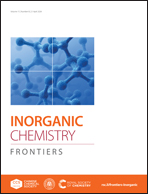Isostructural chiral metal–organic frameworks with metal-regulated performances for electrochemical enantiomeric recognition of tyrosine and tryptophan†
Abstract
The electrochemical enantiorecognition of amino acids has wide applications, but the creation of the required uniform and homochiral microenvironments at electrodes remains a huge challenge. With highly ordered and adjustable structures, homochiral MOFs may provide nice platforms for fine regulation of the microenvironments. Herein, we report for the first time the distinct enantiodiscriminative abilities controlled by metal centers in isostructural homochiral MOFs. Cu–TBLeuBpa, which has a L-leucine-derived linker with Cu(II) in a severely elongated octahedron, displays highly efficient enantiomeric discrimination of Tyr and Trp, with high current ratios (IL/ID, up to 9.83), large potential differences (EL–ED, up to 160 mV), and ultralow detection limits for the L-isomers (2–4 nM). The overall performance is remarkably superior to previous sensors for these amino acids. The Cu–TBLeuBpa sensor has been successfully utilized for the quantitative assay of L-Tyr and L-Trp in racemic mixtures and human urine. We demonstrated that not only the chiral aliphatic amino acid moiety but also the achiral aromatic moiety (phenol or indole) plays a decisive role in the biased adsorption and electrochemical recognition of the L isomers. In contrast, the isostructural Co–TBLeuBpa, in which Co(II) shows a quasi-regular octahedron, is unable to distinguish Tyr enantiomers and shows weakened but still conspicuous performance for Trp enantiomers. This work highlights that a small alteration of the metal geometry in MOFs can have a significant or even decisive impact on enantiorecognition, opening up new perspectives for the design of chiral sensing materials.



 Please wait while we load your content...
Please wait while we load your content...